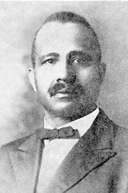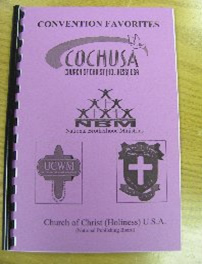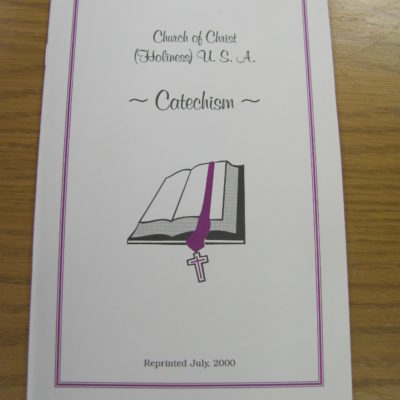History | Board of Bishops | What We Believe | Core Values | Diocese Locations | Ministries
 Born: December 9, 1865
Born: December 9, 1865
Place: Texas Valley, Georgia (near Rome, Georgia) – Reared in Kingston, GA
1874
He had public school training by J. E. Bush from Talladega College, who took an interest in him.
After the death of his mother, he moved to Cedartown and Rome, GA; from there to Chattanooga, TN. Sixteen months later, he moved to Memphis, TN; from there to Arkansas. He then moved to Cat Island Arkansas.
1882
Mother: Mary Jones
Step-Father: Berry Latimer
His mother loved God and was a praying mother. She often woke him at night when she was praying crying out to God to save him. Many times she broke his heart by her forcible impressive pleadings for him to be a Christian. She wrestled with God on his behalf because of her love for him, with her being strict, God answered her prayers. He confessed that he owed his success in life’s work to his mother who died: July 12, 1882 when he was only 17 years of age.
The other greatest religious influences in his life were Miss Ada Dawson and Reverend Humphrey Daniels, pastor of Shiloh Baptist Church in Kingston GA. Reverend Daniels was his mother’s pastor. Even though things were difficult for him, Charles Price Jones believed in Excellency in whatever he attempted to do.
1884
He was converted in Cat Island Arkansas in October. Afterward he became very ill and others cared for him.
1885
While in Cat Island he joined the Locus Grove Baptist Church and was baptized by Elder J. D. Petty in Crittenden County AR. On the day of his baptism, he began teaching Sunday School the same day. He was called to the ministry and began preaching in 1885.
1887
He received his license to preach by Elder George W. Dickey.
1888
He moved from Cat Island AR to Forest City AR; then to Helena where he was under watchcare of Centennial Baptist Church under the great E.C. Morris who afterwards was President of the National Baptist Convention. From Helena he moved to Little Rock, AR and entered the Arkansas Baptist College. He taught school in Grant County, AR.
In July, 1888 he became pastor of Pope Creek Baptist Church.
In the month of October, he was ordained to the ministry in Mount Zion Baptist Church by Dr. C. L. Fisher. It was a presbytery of reputable men, both white and colored before whom his examination was very excellent. In their newspapers he was highly commended for his excellence.
He pastored Saint Paul Baptist Church in Little Rock where Bishop J.A. Jeter served as a deacon. He served as corresponding secretary for the Baptist State Convention; and as a trustee and auditor for the Arkansas Baptist College.
1891
He graduated from the academic course of the Arkansas Baptist College and was called to Bethlehem Baptist Church in Searcy, AR, while there he became editor of the Baptist Vanguard Newsletter.
1892
He accepted the call to the Tabernacle Baptist Church in Selma AL which was the College Church of Selma University, and pastored there two and one half years. “I was very popular as a pastor and evangelist everywhere, for as Doctor J.H. Hoke of Arkansas once said, my ‘word was with power.’ I loved Jesus, Power belongs to God. Know God.” It was said that no doubt it was one of the fastest growing churches ever formed in the State.
It was in February of this year that he married his wife Fannie and they had one daughter, who died in a fire when she was only four years old. His wife, Fannie died in 1916. He later married his second wife, Pearl and they had three sons.
1894
While living in Selma, he realized that he needed a deeper experience of grace and more power in his life. He said, “I asked God for grace and God demanded that I let Him sanctify me. It was there I fasted and prayed three days and nights and God sanctified me sweetly in His love. New visions of Christ, of God and of truth were given to me. It was the nearness, the imminence and the reality of the presence of God that exalted my spirit and filled me with joy…the joy of the Holy Ghost. This made me feel keenly unworthy and in need daily of His amazing grace. My ministry was blessed in Selma AL.”
1895
He accepted the call to Mount Helm Baptist Church in Jackson, MS. He had been called there twice; previously in 1893 after a revival and in 1894. This time he went and he said “his large and greatest work was done at this church.” He began to promote and teach holiness with no thought that it was about to stir up a storm. He had no idea of taking up holiness as a fad or creed; He stated that “I just wanted to be personally holy. I just wanted to walk with God in the Spirit.” His toil and suffering was also great. The newspapers covered him with calamity, shame and falsehood but he stood on the word of God in his darkest hour and God always brought him out in due time and in His own way. He said, “I rejoiced in the Lord.”
1896
Following a pattern of conventions and camp meetings, he called his first of several “Holiness Conventions.” He invited pastors and laymen who agreed with the Holiness teachings to gather for Bible Study, exhortation and prayer.
He organized the Young Men’s Christian League after he called together the zealous young men of the city. This Christian League was to help the men develop and exercise ministry for the Lord’s church.
He published his first booklet, The Work of the Holy Spirit in the Churches. It was a study of the spiritual gifts in 1 Corinthians 12. He also became editor and publisher of the TRUTH and did this work in his office along with many books and tracts. All of his work seemed to be going forward but there was much opposition. Many people over-reacted at this holiness teaching and thought it was heresy; even some of the members of his church (Mount Helm Baptist Church). The brethren did not appreciate the new teaching and the Holiness Doctrine. Many thought Jones was a fanatic; others looked upon him as a weak brain and others as a sharper trying to distinguish himself by being different.
Opposition led him to take a serious step to build another sect, which was not his aim or desire. He contended that Christ is all. He sought to reorganize the church as a Holiness congregation. He said, “What we do not understand, we fear and fight.” A minority of the membership opposed the move and with the support of other Baptist churches took him to court. The case remained in court almost three years.
1898
The fight began against them and it was hard. The move on the part of Mt. Helm voted to remove the name “Baptist” and change the name of the church to ‘Church of Christ’ with no creeds and denominational association. In his zeal to be entirely Scriptural, not anti-Baptist, as the Baptist claimed to be.
1899
From the very beginning, the Holiness movement had promoted its teachings through conventions and camp meetings. After much suffering, fasting and prayer he was encouraged by God through the Holy Spirit to write songs for his people. He wrote songs, hymns and anthems extensively. The first song book was “One Hundred Hymns” words only. The second book was “Sweet Selections.” However, Jesus Only No. 1 was his first published song book.
1901
He published his second song book Jesus Only Nos. 1 and 2. Every song written, he gave the Scripture quotations or references under the titles of his songs to show what passage inspired the song.
1901, October
The Supreme court which had overturned the lower court ruling which had given them a victory. The decision was not on general law, but on a technicality involved in the Mt. Helm holdings of the property as was deeded to the church by Mr. Helm.
1902
He and his followers were then forced to leave the Mt. Helm property by an expulsion notice. He and the majority of the congregation who left with him (white and colored) began holding services in an empty store, where he addressed the people from the counter. They went through a series of rented halls as meeting places until they could finally construct their own building. He did not face this battle alone; the majority of the congregation from Mount Helm Baptist Church and other preachers stood by him. Elders: J. A. Jeter, C. H. Mason, W. S. Pleasant; R. J. Temple and many others were with him.
1902, October
He published “An Appeal to the Sons of Africa,” (still in print today) a number of poems, readings, orations and lectures, designed especially to inspire youth of African blood with sentiments of hope and true nobility as well as to entertain and instruct all classes of readers and lovers or redeemed humanity.
1903
The congregation was able to build the first Christ Temple Church or Christ Tabernacle (as it was sometimes called) which housed a print shop and a parsonage. They only enjoyed it for two years.
1905
A white mob approached the church using dogs, claiming they were trailing a black man who had assaulted a white woman in another part of town, and had tracked their quarry to the church. The mob got coal oil and set the church on fire; they said the culprit was under the church and nobody believed them. It was a case of malicious vandalism. When the fire fighters got to the scene, the mob would not let them put out the blaze. The congregation could do nothing but watch helplessly as the church collapsed in a fiery inferno. The fire also totally destroyed the print shop, which contained two thousand newly printed hymnals.
1906
The congregation was a bit weary, but determined. They built a new brick structure that could seat two thousand people at an approximate cost of $16,000 with interest and improvements, the total estimated cost was $20,000. Jones was very active in church planting and evangelism. He conducted evangelistic campaigns which led to the founding of many congregations.
1906
He published the His Fullness Song Book.
1906
The Azusa Street Pentecostal Revival began in Los Angeles California and Elder C.H. Mason and two of their (Jones and Mason) friends is in attendance when Elder C.H. Mason has a Pentecostal experience.
1907
Elder C.H. Mason and his colleagues return from California and shared their experience with Elder C.P. Jones, but Jones was not convinced with the propriety of Pentecostalism which caused the two to separate. Elder Mason withdrew from the movement and appropriated the name “The Church Of God In Christ” which began a two year legal battle between Jones and Mason for the rights to the name and some property. The final decision from the court in 1909 allowed Elder C.H. Mason and his followers to retain the name “The Church of God in Christ.”
1909
The Church chartered the name of its private school which was moved to north Jackson in 1907 as Christ Missionary and Industrial College.
1911
From 1900 there were several names used for the movement of churches, they are: Church of God, Church of Christ, Church of God in Christ then in 1911 the convocation changed the name of the church to Church of Christ (Holiness) U.S.A.
1917
This Holiness Denomination began moving beyond the Deep South in Mississippi to the North and the West. He (C.P. Jones) led the organization of Christ Temple Church in Los Angeles CA, he moved the printing press there. Soon congregations were in Chicago IL; Saint Louis MO; Cleveland OH; San Diego CA; and Indianapolis, IN.
1920
The churches and its associations across the country with Elder Jones officially chartered the name the Church of Christ (Holiness) U.S.A. as a denomination.
1927
He developed a church government and began to see constant growth and expansion of the church he had founded. It was in the same year that the church adopted an episcopal form of government having bishops as its head.
1944
During his final years, he was able to visit the church he had pastored for a long time in Los Angeles CA. One of the members of the congregation stated, Bishop Jones, with tears running down his tired face said in his feeble voice, “Little children, love one another.”
In his lifetime, he was instrumental in turning many to righteousness, winning many souls, starting many churches, revolutionizing the churches of men and converting them to God. He was a man of prayer and God used him to save souls, heal the sick and in doing all that Christ bade His disciples to do.
1949
He died January 19th in Los Angeles CA and his funeral was held on January 25th at Christ Temple Church of Christ (Holiness) U.S.A. Los Angeles CA, his pastorate of twenty eight (28) years at 1:00 P.M. with Bishop E.W. Butler Officiating.




